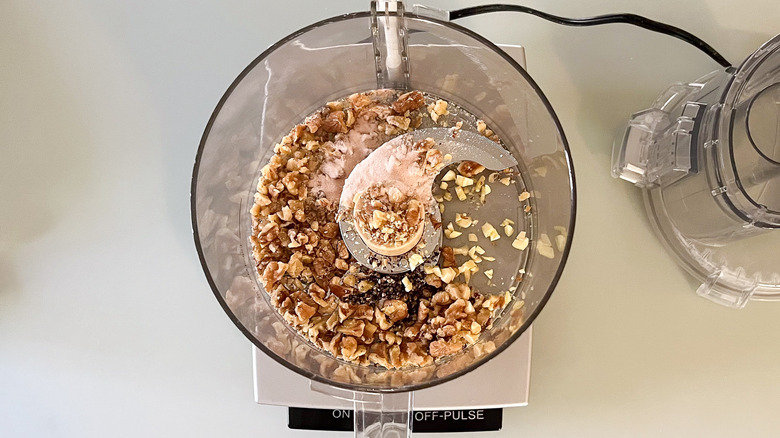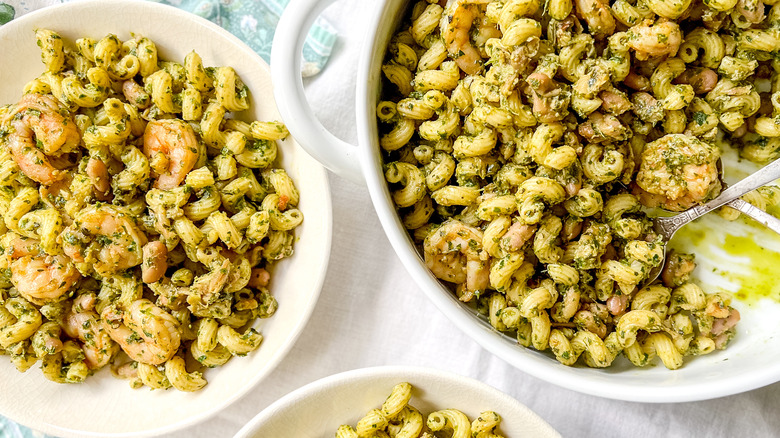Walnut Pesto Pasta With Shrimp Recipe
Few culinary combinations are better than an Italian trilogy of pasta, pesto, and seafood. This classic combo is especially popular in the northwest region of Liguria, from where the classic pesto alla Genovese hails. Traditional Genovese pesto — made from pine nuts, garlic, fresh basil, hard cheese, and olive oil — is the pesto most people are familiar with. The word "pesto" derives from the Italian verb "pestare," which means to pound, referring to the traditional method of using a mortar and pestle to grind the pesto ingredients into a paste by hand.
When it comes to specific pesto ingredients, infinite combinations exist in Italy and beyond, making pesto as unique as its maker! In this recipe for walnut pesto pasta with shrimp, courtesy of recipe developer Julie Kinnaird, fresh Italian parsley and rosemary stand in for basil, while walnuts fill the role of pine nuts. Cheese is absent in this version, but there is still plenty of garlic and olive oil. A food processor takes the job of the mortar and pestle for a fresh, fragrant pesto that comes together in minutes.
Choosing a pasta for this recipe is important. Corkscrew-shaped cavatappi have a sturdy spiral shape with ridges that allow the pesto to cling to the surface. Fusilli or gemelli would also work as great pasta shape options. Canned beans add texture and protein to this dish, and additional chopped walnuts give a contrasting crunch.
Gather the walnut pesto pasta with shrimp ingredients
For the pesto, you will need raw walnuts, fresh garlic, sea salt, black pepper, fresh Italian parsley, rosemary, and flavorful extra virgin olive oil. Freshly squeezed lemon juice helps the pesto stay a verdant green color by preventing oxidation. The shrimp should be peeled and deveined before marinating in olive oil, lemon zest, garlic, and smoked paprika. Finally, cavatappi is a perfect pasta shape for this recipe, and canned cannellini beans and additional raw walnuts complete the dish.
Step 1: Prep the pesto
To prepare the pesto, place walnuts, garlic, sea salt, and black pepper in the bowl of a food processor.
Step 2: Process the walnuts and garlic
Pulse until very fine.
Step 3: Add the herbs, lemon, and olive oil
Add parsley, rosemary, lemon juice, and olive oil. Process until the pesto is smooth but still has a bit of texture, scraping down the sides of the bowl as needed. Set aside.
Step 4: Marinate the shrimp
In a large bowl, combine the shrimp, 1 tablespoon olive oil, lemon zest, garlic, smoked paprika, and ½ teaspoon sea salt. Toss to coat.
Step 5: Boil water for the pasta
Bring a large pot of water and the remaining teaspoon salt to a boil.
Step 6: Cook the pasta
Add the pasta to the boiling water and cook until al dente, according to package directions.
Step 7: Heat the oil in a skillet
Meanwhile, place the remaining 1 tablespoon olive oil in a large skillet over high heat.
Step 8: Cook the shrimp
Add the shrimp and cook just until they start to turn pink.
Step 9: Add the walnuts and beans
Add the walnuts and cannellini beans to the shrimp. Cook, stirring, for 1 minute, then turn off the heat.
Step 10: Drain the pasta
Drain the cooked pasta.
Step 11: Add the pasta to the shrimp
Add the pasta to the pan with the shrimp.
Step 12: Add the pesto
Add the pesto and toss to coat thoroughly.
Step 13: Serve hot
Serve pasta immediately in warmed bowls.
How can I switch up walnut pesto pasta with shrimp?
Although the pesto ingredients for this recipe were specifically chosen to work in harmony with the shrimp, Kinnaird explains that there are still plenty of ways to introduce variety. "Rosemary and Italian parsley both have a nice affinity to seafood, however, mixing in a bit of mint rather than rosemary or replacing some of the parsley with traditional basil would also pair nicely with the flavor of the walnuts." The size of the shrimp and whether or not to leave the tails on is up to user discretion, as well. Tiny salad shrimp might get lost in this preparation, but jumbo shrimp served atop the pasta would add some visual flair.
If gluten is a no-go for you, simply substitute an equal amount of gluten-free pasta, paying close attention to cooking time so the pasta keeps a good al dente texture.
Can you make walnut pesto pasta with shrimp in advance?
This walnut pesto pasta with shrimp is best enjoyed immediately after cooking, but there are components that can definitely be prepared in advance. The pesto can be made and refrigerated in a glass jar for up to a week; just add a thin layer of olive oil over the top of the pesto to seal off air from the surface. Bring the pesto back to room temperature before using.
The shrimp may also be marinated a day ahead and kept in the refrigerator until ready to cook. If you do have pasta leftovers, they will keep well under refrigeration for 2 days. Add a tablespoon or so of water to the pasta when reheating in the microwave to prevent it from drying out, and use a medium power setting in the microwave to avoid overcooking the shrimp and causing it to be tough.
Walnut Pesto Pasta with Shrimp Recipe
Crowd-pleasing pesto pasta is even more satisfying with the additions of shrimp, cannellini beans, and chopped walnuts.

Ingredients
- For the pesto
- ⅓ cup raw walnuts
- 1 large clove garlic, chopped
- 1 teaspoon sea salt
- ½ teaspoon freshly cracked black pepper
- 3 cups packed fresh Italian parsley leaves
- 2 tablespoons fresh rosemary leaves
- 1 tablespoon fresh lemon juice
- ½ cup extra virgin olive oil
- For the pasta
- 1 pound large shrimp, peeled and deveined
- 2 tablespoons extra virgin olive oil, divided
- Zest of 1 large lemon, finely chopped
- 1 large clove garlic, chopped
- ½ teaspoon smoked paprika
- 1 ½ teaspoons sea salt, divided
- 1 pound cavatappi or other chunky pasta
- ½ cup raw walnuts, roughly chopped
- 1 (15-ounce) can cannellini beans, rinsed
Directions
- To prepare the pesto, place walnuts, garlic, sea salt, and black pepper in the bowl of a food processor.
- Pulse until very fine.
- Add parsley, rosemary, lemon juice, and olive oil. Process until the pesto is smooth but still has a bit of texture, scraping down the sides of the bowl as needed. Set aside.
- In a large bowl, combine the shrimp, 1 tablespoon olive oil, lemon zest, garlic, smoked paprika, and ½ teaspoon sea salt. Toss to coat.
- Bring a large pot of water and the remaining 1 teaspoon salt to a boil.
- Add the pasta to the boiling water and cook until al dente, according to package directions.
- Meanwhile, place the remaining 1 tablespoon olive oil in a large skillet over high heat.
- Add the shrimp and cook just until they start to turn pink.
- Add the walnuts and cannellini beans to the shrimp. Cook, stirring, for 1 minute, then turn off the heat.
- Drain the cooked pasta.
- Add the pasta to the pan with the shrimp.
- Add the pesto and toss to coat thoroughly.
- Serve pasta immediately in warmed bowls.
Nutrition
| Calories per Serving | 1,131 |
| Total Fat | 53.2 g |
| Saturated Fat | 6.8 g |
| Trans Fat | 0.0 g |
| Cholesterol | 182.6 mg |
| Total Carbohydrates | 117.6 g |
| Dietary Fiber | 13.0 g |
| Total Sugars | 5.2 g |
| Sodium | 1,095.1 mg |
| Protein | 51.0 g |


















